Physical Address
304 North Cardinal St.
Dorchester Center, MA 02124
Physical Address
304 North Cardinal St.
Dorchester Center, MA 02124
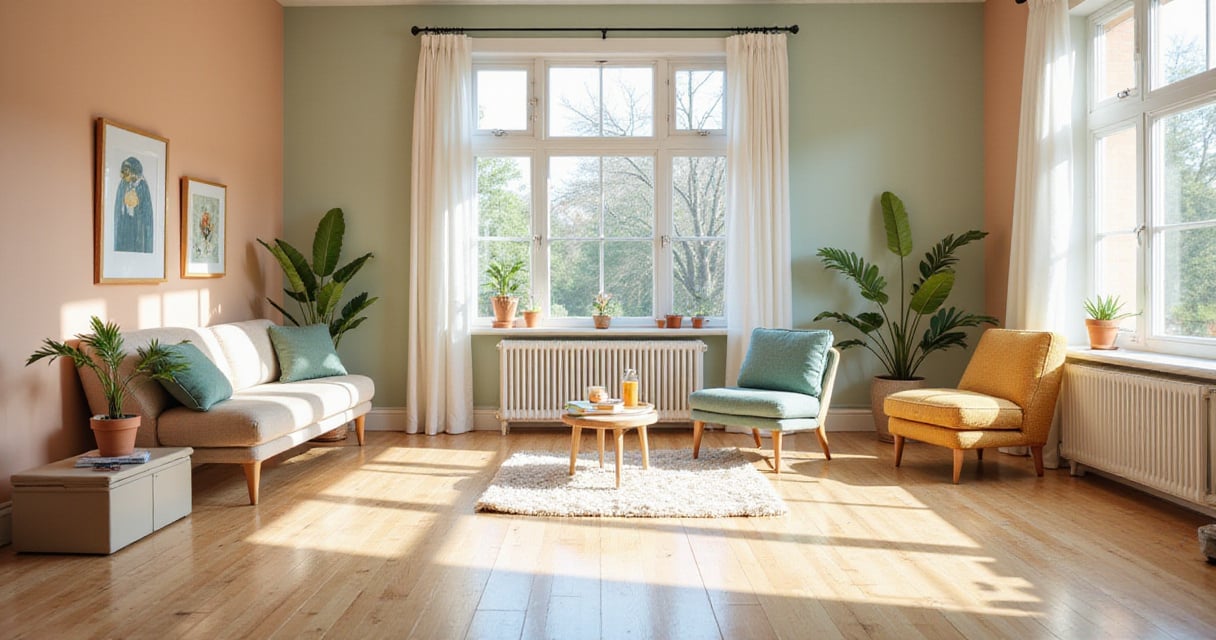
Transform your space with 24 brilliant living room walls decorating ideas. From paint to murals, discover budget-friendly solutions that add style and function.
Staring at a blank wall? I get it. That big, empty expanse of builder’s beige or stark white can feel more intimidating than inspiring. It’s a quiet pressure, isn’t it? As both an artist and a designer, I’ve spent years in studios and homes watching people wrestle with their walls. These vertical planes do more than just hold up the ceiling; they frame our lives, our conversations, and our quiet moments. The magic happens when we stop seeing them as boring structural necessities and start seeing them for what they are: canvases waiting for a story.
I’ve seen it time and again in my own work. A well-considered wall doesn’t just look pretty; it fundamentally changes how a room feels. It can make a cramped craft room feel expansive, or a cavernous living room feel intimate and enveloping. It’s about more than just decoration. It’s about shaping an environment that nurtures your creative soul and supports the way you actually live.
So, let’s get into it. Forget cookie-cutter solutions. These aren’t just “ideas”; they are starting points for a conversation between you and your space. Whether you’re ready for a dramatic statement or just a subtle shift, here’s how you can make your walls come alive.
Okay, let’s talk paint. But not in the way you might be thinking. Don’t just march into a store and grab a paint chip that looks nice under the harsh fluorescent lighting. That’s a recipe for disappointment. The real secret to choosing a color is to become a student of the light in your own room. How does the morning sun hit that one corner? What does the light look like in the afternoon, when it’s soft and golden? A north-facing room has a cool, consistent light that is completely different from the warm, direct light of a south-facing one.
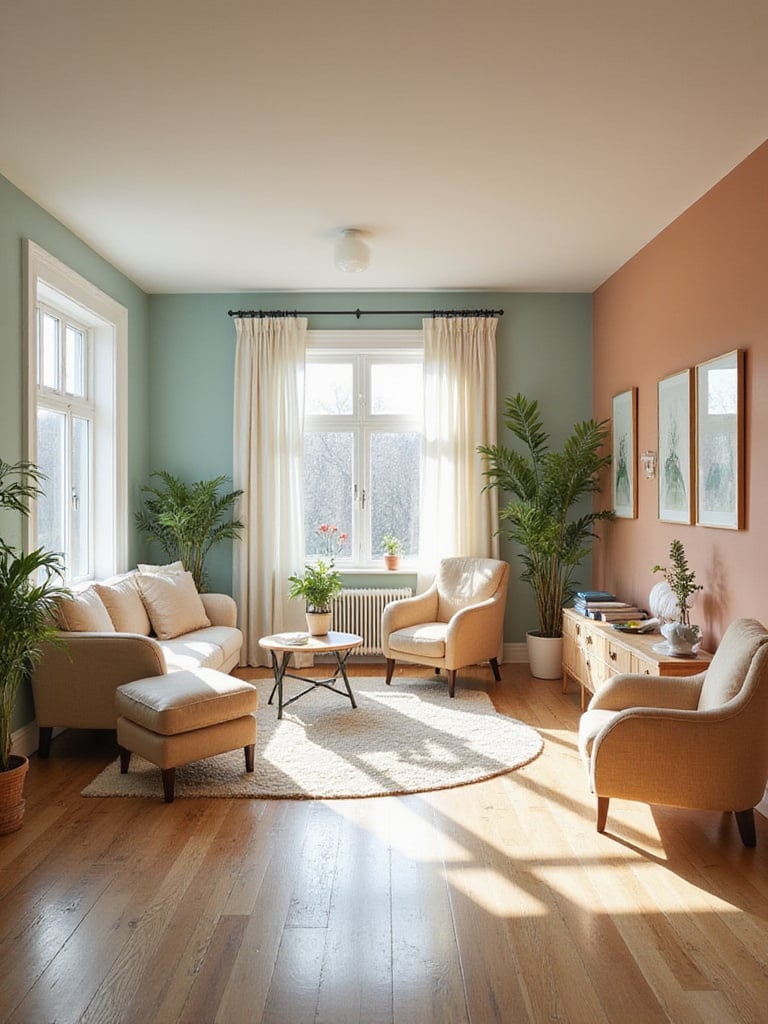
Once you start observing, you can work with the light instead of against it. For a photography studio client whose space felt a bit tight, we used a soft, cool blue that almost seems to push the walls back, making it feel bigger and airier. In contrast, I once used a warm, earthy terracotta in a large, echoey live/work loft to create a sense of grounded intimacy. You have to test your contenders. And I don’t mean a tiny 2-inch square. Get a sample pot, paint a huge two-foot square on a piece of foam core, and move it around the room for a couple of days. Watch how it changes. It’s an investment of time, but it saves so much heartache.
Once you’ve found that perfect base color, that true soul-mate-of-a-paint-chip, you might feel the pull to do something even more dramatic on just one surface.
An accent wall shouldn’t be random. Please, don’t just paint the smallest wall a loud color and call it a day. Think of it as a strategic tool. In an open-concept space, an accent wall can be a powerful anchor, visually separating the living area from the dining space or carving out a dedicated workspace. What’s the natural Focal point of your room? Usually, it’s the wall behind your sofa or the longest, most uninterrupted surface. That’s your canvas.
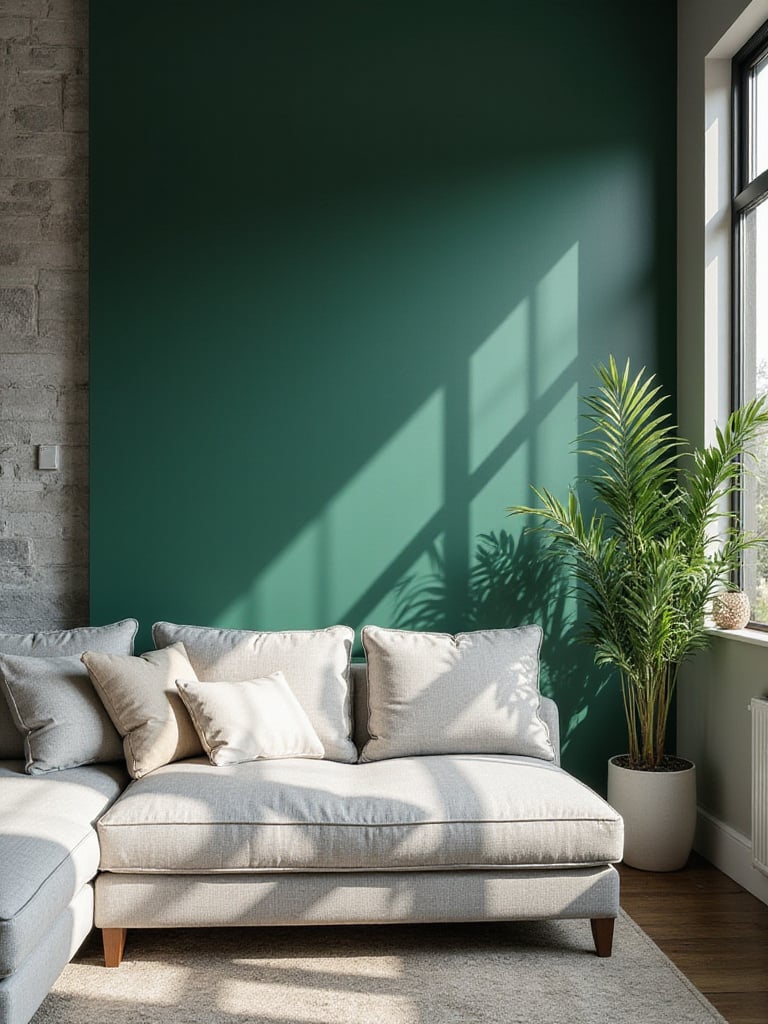
And it doesn’t just have to be paint. This is where your inner artist can really come out to play. Think texture. I’m talking about rich grasscloth, Reclaimed Wood planks that tell a story, or even a veneer of painted brick to add some urban grit. I once worked on a project where we installed a deep emerald green, suede-like wallpaper behind a client’s collection of vintage brass instruments. The texture didn’t just add color; it absorbed sound and gave the wall a tactile depth that made the whole room feel richer and more luxurious. Just be mindful of scale—a bold, huge pattern needs a big room to breathe, while smaller spaces often do better with subtle, touchable textures.
Now, an accent wall works to define a single surface. But what if you want to tell a story across that surface?
A gallery wall is so much more than a jumble of pictures. It’s your story, told in snippets. A visual memoir. It’s the concert ticket from a life-changing show, a quick sketch you did on a napkin, a postcard from a friend, a child’s first painting. At first, I thought the secret to a great gallery wall was having a rigid theme or matching frames, but over years of creating them, I’ve realized it’s all about rhythm. What’s the conversation happening between that stark black-and-white photograph and the vibrant abstract print next to it?
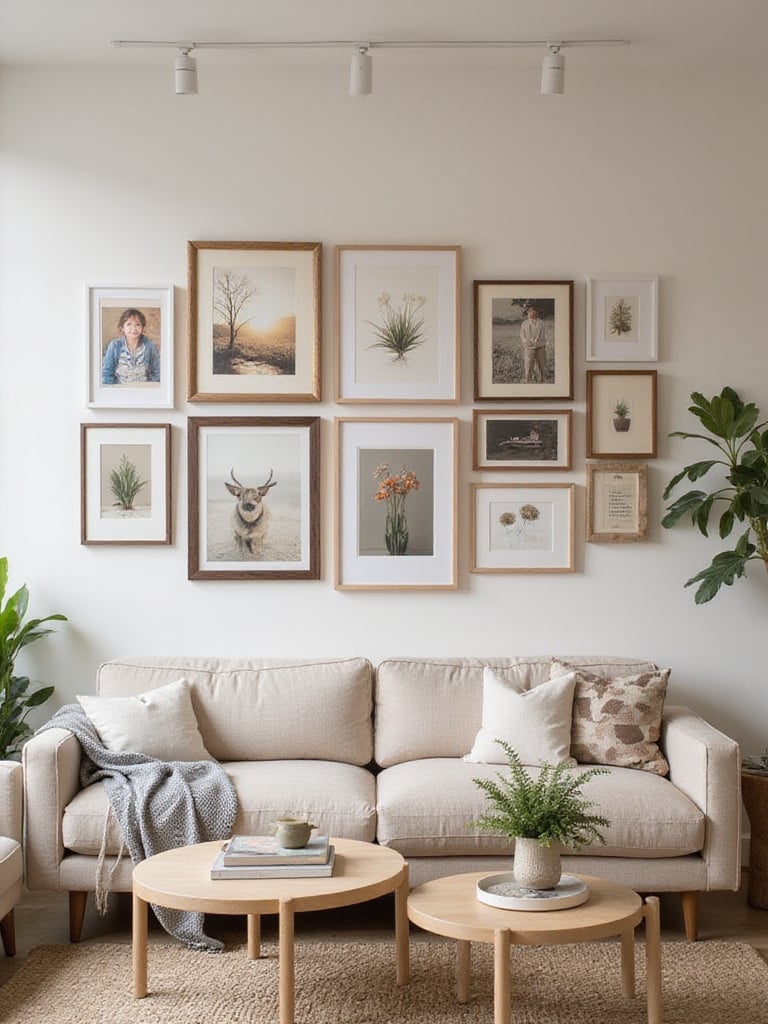
But even the best rhythm needs a solid structure. This is where the designer brain kicks in. Before a hammer ever meets a nail, lay everything out on the floor. Get a feel for the spacing and flow. Then—and this is the part everyone wants to skip—trace each frame onto kraft paper, cut out the templates, and tape them to the wall. Live with it. Does it feel balanced? Too crowded? This simple step has saved my clients (and me!) from countless “regret-holes” in the wall. It’s the difference between a random assortment and an intentional, curated collection.
A whole collection can feel like a big project, though. Sometimes, what a room really needs isn’t a chorus of voices, but a powerful soloist.
If you want to make a statement, and I mean a real statement, one massive piece of art can do more for a room than almost anything else. It’s simplicity at its most dramatic. The key here is proportion, something that can feel tricky. A good rule of thumb I’ve developed is to find a piece that’s about two-thirds to three-quarters the width of the furniture it’s hanging above. This creates a pleasing visual anchor; the art and furniture feel connected, like they’re in a relationship.
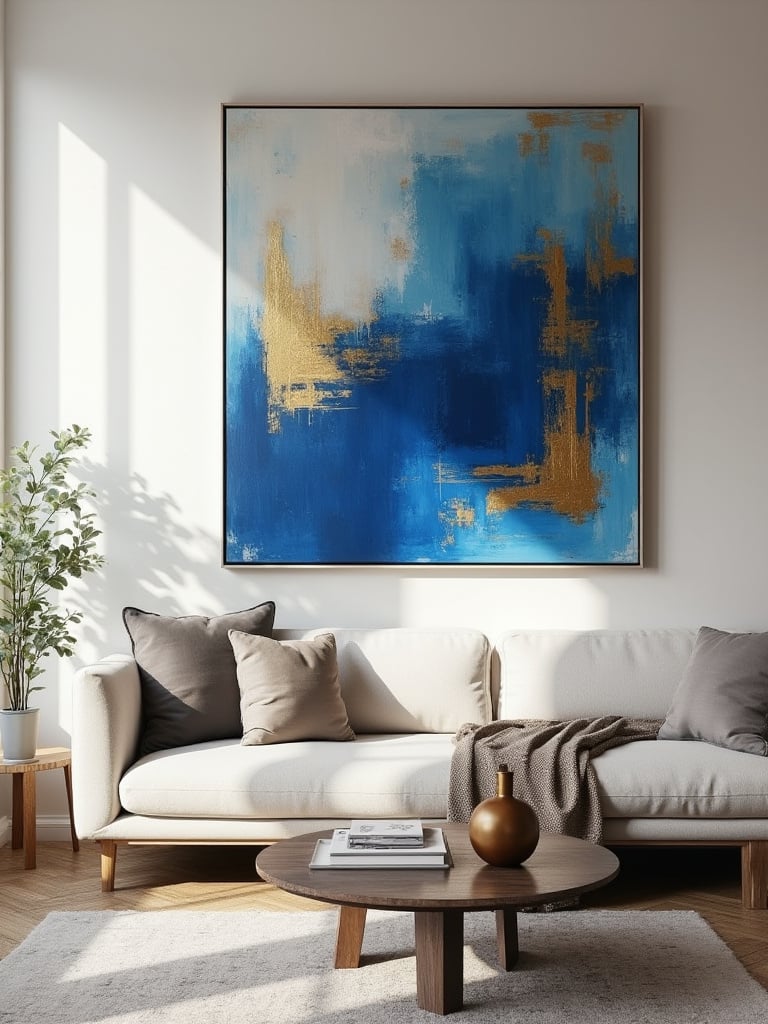
This single piece sets the entire mood. A huge, energetic abstract can infuse a room with dynamism, while a massive, serene landscape photograph can bring a sense of calm. Height is also critical here. So many people hang art way too high, making it feel disconnected. Aim for the center of the piece to be at eye level, which is roughly 57 to 60 inches off the floor. Then, make sure the bottom of the frame is about 6 to 8 inches above the back of your sofa or console. This closes the gap and makes the whole vignette feel cohesive. Instant drama, without the clutter.
Of course, finding that one perfect piece is a journey. Often, the most powerful walls showcase a collection built over time.
This is different from a gallery wall of personal photos. This is about curation—gathering pieces that speak to each other and tell a larger story about you. Maybe you collect ceramic plates, or prints from local artists, or small oil paintings from your travels. The power isn’t in any single piece, but in how they converse as a group. This is for the collectors, the travelers, the people whose passions are too big for one frame.
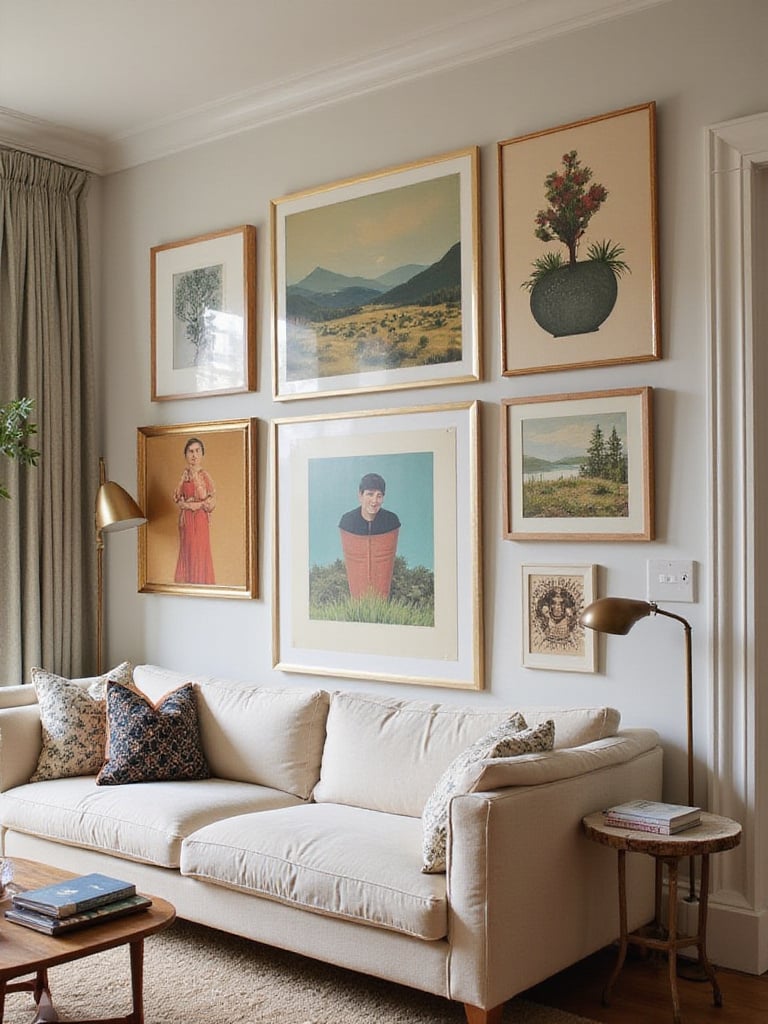
The process has to start with what genuinely moves you, not what you think will match your sofa. Let that be your guide. I worked with a writer who had collected dozens of portraits of people reading. Individually, they were just nice pictures. But when we grouped them together on one wall, they became this profound statement about her life’s passion. You can group by color, by medium, by theme, or even by a memory. And don’t feel the pressure for it to be “done.” A great collection should be a living thing, with pieces coming and going as you evolve.
Your art deserves to be shown off properly, and sometimes that means building it a home right into the wall.
I love floating shelves. Honestly, they’re one of the most versatile tools in a designer’s kit. They turn empty vertical space into a curated stage for your objects without the visual bulk of a traditional bookcase. When installed correctly—and I mean anchored into studs—they can hold a surprising amount of weight, making them perfect for books, plants, and your favorite collected objects.
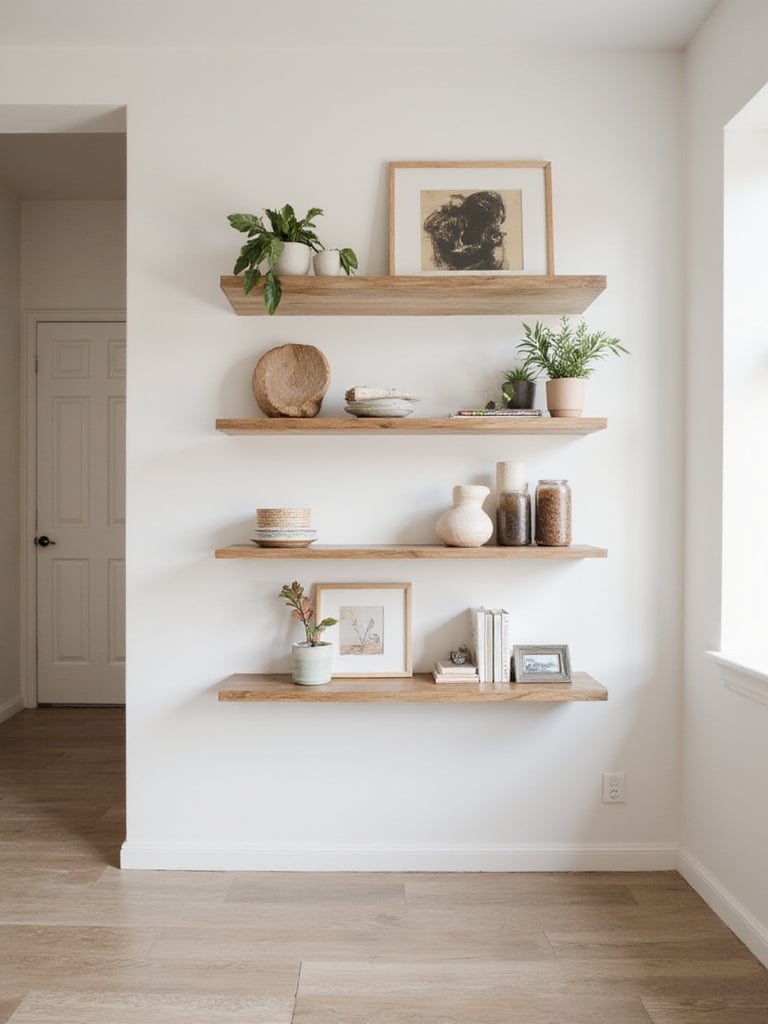
The trick is to think like a sculptor. Don’t just line things up. Create little vignettes. Vary the heights and textures. Group objects in odd numbers (threes and fives are always pleasing to the eye). Most importantly, leave some breathing room! Negative space is just as important as the objects themselves; it’s what keeps the shelf from looking like a cluttered mess. I’m also a huge fan of installing thin LED light strips underneath the shelves. It adds a warm, ambient glow and makes your displayed items feel like they’re in a gallery.
Floating shelves give you an architectural look, but for the ultimate integrated feel, nothing beats custom built-ins.
Built-ins are the dream, aren’t they? They represent a complete fusion of storage and style, making your shelves feel like they were part of the home’s original DNA. Unlike a freestanding bookcase that you plop against a wall, built-ins can be designed to fit the quirks of your space perfectly—those awkward nooks around a fireplace, the weirdly shaped wall in an old house. This is especially brilliant in smaller rooms where every single inch counts.

The key to making them look truly custom is in the details. They should echo the architectural language of your home. The trim should match your existing baseboards or crown molding. I often advise clients to incorporate a mix of open shelves for displaying beautiful things and closed cabinets below for hiding the necessary-but-not-so-pretty stuff (like board games or electronics). Painting them the same color as the walls creates a subtle, sophisticated texture, while a contrasting color turns them into a stunning focal point. It’s an investment, but one that adds serious character and value.
Whether they are built-in or floating, your shelves will benefit from the oldest trick in the designer’s book: amplifying light.
Using mirrors to make a space feel bigger isn’t exactly a new idea, but the execution is what separates a good result from a great one. It’s architectural magic. Placing a large mirror directly across from a window is the classic move, and for good reason—it effectively doubles your natural light and can even reflect a beautiful outdoor view, making it feel like a second window. This is a non-negotiable for me in city apartments or any space that’s starved for sunlight.
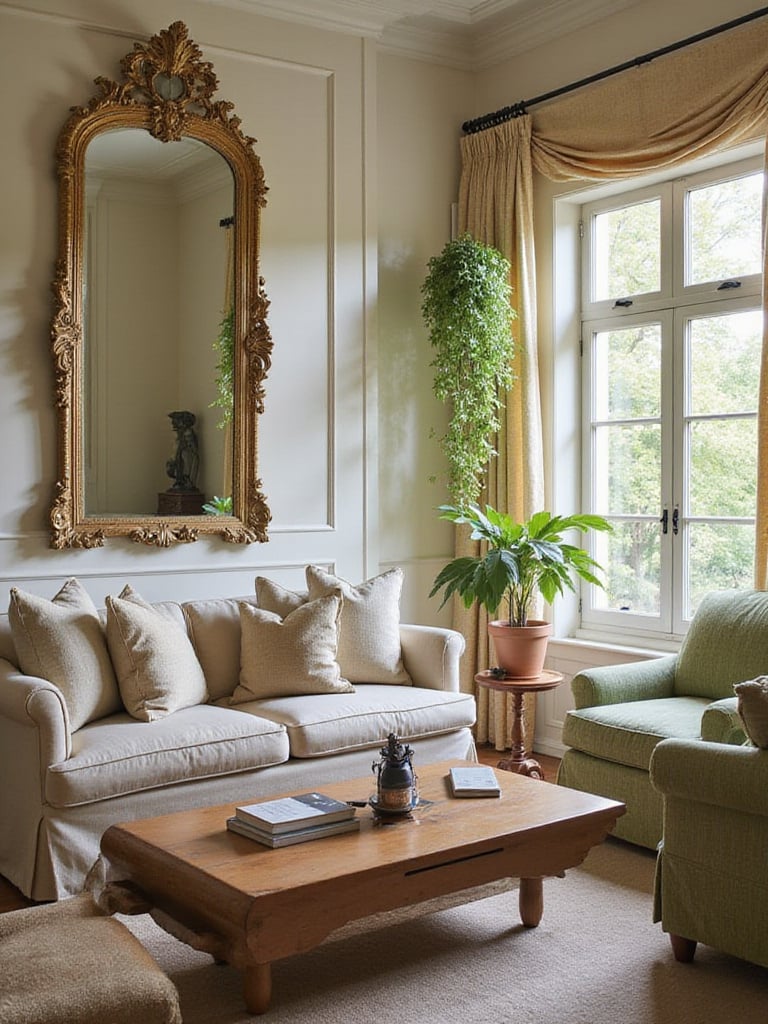
But think beyond just reflecting light. A mirror can also correct a room’s proportions. A long, horizontal mirror can make a narrow room feel wider. A tall, floor-to-ceiling mirror can create the illusion of a higher ceiling. Here’s the critical part: always be mindful of what your mirror is reflecting. There’s nothing worse than a beautifully framed mirror that perfectly reflects a messy corner or a blank, boring wall. Angle it to capture something lovely—a favorite piece of art, a styled vignette, or an interesting architectural detail.
If you crave a new view but aren’t ready for construction or custom art, there’s an amazing middle ground.
I know what you’re thinking. You’re having flashbacks to that flimsy, bubbly contact paper from your college dorm, right? Stay with me. Today’s peel-and-stick wallpaper is a different beast entirely. It has revolutionized decorating for renters, commitment-phobes, and anyone who loves to change things up. You can experiment with a bold, graphic pattern without the stress of traditional wallpaper paste and professional installers.
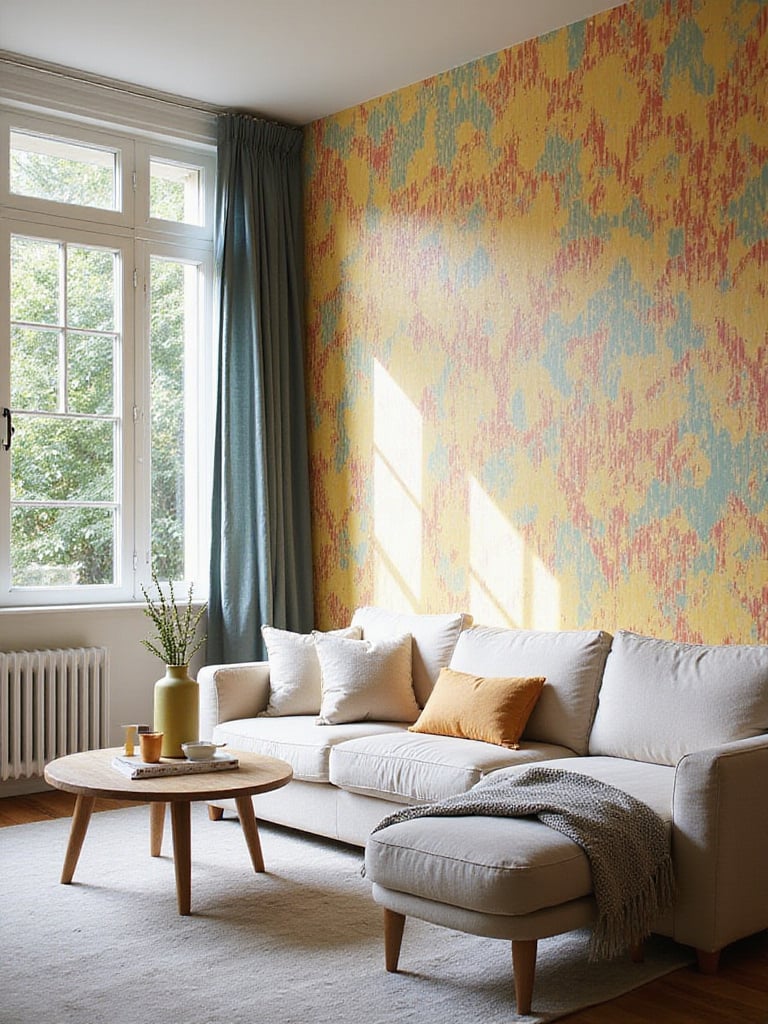
The application does require patience. You need to start with a clean, smooth wall and a plumb line to ensure that first panel is perfectly straight. But the payoff is huge. I’ve used it to create dramatic feature walls behind beds, to line the back of bookcases for a pop of color, and even to give boring, flat-pack furniture a custom look. A word of warning: quality varies wildly. Don’t cheap out. Invest in a reputable brand, read the reviews, and order a sample to test both the look and its removability before you commit to doing a whole wall.
Wallpaper offers pattern, but if you’re looking to add softness and warmth, texture is the answer.
So many modern living rooms are filled with hard surfaces—wood floors, metal accents, glass tables, a giant TV screen. It can all start to feel a little cold and echoey. This is where textile art, like a woven tapestry or a large-scale macrame hanging, works its magic. These pieces do more than just add visual interest; they literally soften the room by absorbing sound and bringing in a much-needed layer of warmth and texture.

The organic, handmade nature of a textile provides a beautiful contrast to the sharp lines of furniture and architecture. When choosing a piece, think about scale. A tiny wall hanging will just get lost above a big sofa. Go for something substantial that can hold its own. The neutral tones common in a lot of fiber art make them incredibly versatile, but I’ve seen some incredible pieces that use bold, vibrant color. What I love most is that they bring a human touch into a space—you can almost feel the artist’s hands at work.
Textiles add a soft layer of detail, but for a more structural and classic effect, nothing beats molding.
Molding is like the eyebrows of a room. You might not notice it when it’s there, but you sure notice when it’s missing. Adding elements like crown molding, a chair rail, or picture frame molding (wainscoting) is one of the fastest ways to add a sense of history, sophistication, and value to a plain, boxy room. These details trick the eye, making ceilings seem higher and rooms feel more grand and intentional.

This isn’t just for traditional homes, either. In a modern space, you can use very clean, simple molding profiles painted the same color as the walls. This creates a subtle, shadow-play effect that adds dimension without feeling stuffy or ornate. A client of mine with a new-build condo felt her living room was a “white box.” We added simple, rectangular panel molding and painted the whole room—walls and trim—in a deep, moody blue. Instantly, the room had bones. It had character. It’s a project that requires precision with your cuts and angles, but the transformation is dramatic.
Molding adds classic texture, and for a more rustic or coastal vibe, you can take that idea even further.
Whether it’s shiplap, beadboard, or board-and-batten, adding wood paneling to a wall or even a ceiling brings immediate character and texture. The horizontal lines of shiplap are fantastic for making a room feel wider and more expansive, while vertical paneling can create the illusion of height. It instantly evokes a certain feeling—coastal, modern farmhouse, or even Scandinavian, depending on how you finish it.

You’ve got options here. Real wood will give you the most authentic look and feel, but high-quality MDF versions can be more budget-friendly and dimensionally stable. The direction is key, but so is the finish. A crisp, classic white is always a winner, but don’t be afraid to go bold. I’ve seen shiplap painted charcoal gray or even black, and the effect is stunningly sophisticated. It turns a simple wall treatment into a powerful architectural statement.
All these wall treatments set the stage. Now, it’s time to light it properly.
Overhead lighting is functional, but it’s rarely flattering. It casts shadows and can feel harsh. This is why a layered lighting plan is so crucial, and wall sconces are my secret weapon for that perfect mid-level glow. They add warmth and depth, freeing up floor space from lamps and table surfaces from clutter. Placed correctly, they can be task lighting for a reading nook or provide a soft, ambient light that makes everyone look good.

The rule of thumb for placement is to hang them around eye level, typically 60 to 66 inches from the floor. This prevents you from staring directly into the bulb while still providing useful light. I’m a huge fan of swing-arm sconces next to a sofa or bed for their flexibility. And always, always put them on a dimmer switch. The ability to control the intensity is everything. You can go bright when you need it, and low and moody for a relaxing evening. Whether you choose a plug-in style or have them hardwired, they will elevate your space.
Sconces provide general ambiance, but your artwork deserves its own spotlight.
You’ve invested time and emotion into choosing art for your home. Don’t let it sit in the shadows. A dedicated picture light is like a custom frame for your artwork—it signals that this piece is important. It eliminates the weird glare and uneven shadows you get from ceiling lights and allows the true colors and details of the art to shine through.

The old, hot halogen picture lights are a thing of the past. Modern LED options are a game-changer. They don’t generate heat that can damage art, they have incredible color accuracy, and some are even battery-powered, meaning no electrician required. Generally, you want to mount the light about 6 to 8 inches above the frame and angle it so the beam of light washes evenly over the entire piece. It’s a small detail that makes your home feel like a curated gallery.
Picture lights are precise, but for a more modern and diffused glow, there’s another LED solution.
LED strip lighting has moved way beyond the college dorm room. It’s now a sophisticated tool for creating incredible lighting effects. These low-profile strips can be hidden almost anywhere—in a ceiling cove, behind a headboard, under cabinets, or along the base of a wall—to wash a surface with a seamless, indirect glow. It feels incredibly custom and high-end.

What’s really exciting is the control you have now. With smart systems, you can change not just the brightness but also the color temperature, from a cool, energizing white light for daytime to a warm, candle-like glow in the evening. You can even program scenes for “movie night” or “reading.” For a truly professional look, make sure you install the strips inside an aluminum channel with a diffuser. This hides the individual LED dots and creates a smooth, continuous line of light. It’s an amazing way to highlight architecture and create an atmosphere.
Atmosphere is also built through personal history, which brings us back to the most personal art of all.
This is your life. Tell its story. A wall of personal photographs turns your home into a living, breathing testament to your relationships, adventures, and milestones. It’s a conversation starter and a source of daily joy. Unlike any other form of art, these images have a direct line to your heart. The key to making it look like an art installation instead of a messy dorm-room bulletin board is curation and consistency.

Think about a unifying element. Maybe you print everything in black and white for a classic, timeless feel. Or perhaps you use the same style of frame—like all simple black frames or a collection of mismatched ornate gold ones. The layout is just as important. Whether you go for a rigid grid or a more organic, sprawling composition, maintaining consistent spacing between the frames is what will make it feel intentional and polished. Mix candid shots with posed portraits, landscapes with close-ups. It creates a dynamic rhythm that keeps the eye moving.
Personal photos are just one type of collection. Your travels and hobbies offer another rich source of display material.
Your treasures shouldn’t be hidden away in a box. Those shells you collected on a special trip, the vintage teacups you hunt for at flea markets, your grandfather’s old cameras—these objects tell your story. Displaying them turns them from clutter into art. But the secret is to think like a museum curator. This means you have to edit. Ruthlessly. You can’t display everything at once. Choose the best, most meaningful pieces for this “exhibition,” and rotate others in later.

How you display them matters. Shadow boxes are fantastic for protecting small, delicate items. A set of floating shelves can become a stage for a collection of pottery. And lighting is your best friend here. A small spotlight on a particularly special object instantly elevates it. Try grouping your items by color, material, or shape. A cluster of all-white ceramics, for example, makes a much stronger statement than if they were scattered around the room. It’s about creating visual impact through thoughtful grouping.
For those who love to switch things up, there are even less permanent ways to make a statement.
Wall decals have grown up. They aren’t just cheesy quotes or cartoon characters anymore. You can find incredibly sophisticated geometric patterns, beautiful botanical illustrations, and subtle textures that can give you the look of custom wallpaper or a painted mural without any of the commitment. This is a perfect solution if you’re a renter, or if you’re like me and just love to change your environment with the seasons.

A little prep work goes a long way. Make sure your wall is clean and smooth. For larger decals, having a second person and a level can make a world of difference. The best part? When you’re ready for a change, they peel right off without damaging the paint underneath. Again, this is an area where quality counts. Read reviews to make sure you’re buying a product that is truly removable and won’t leave a sticky mess behind. It’s maximum impact for minimal commitment.
Decals are fantastic, but if you’re ready for the ultimate in personal expression, nothing compares to a mural.
A custom mural is the absolute pinnacle of personalized wall treatment. It’s a one-of-a-kind piece of art created specifically for you and your space. This isn’t just decoration; it’s a collaboration between you and an artist to create something truly unique that will become the heart and soul of your home. It can be anything from a subtle landscape that adds a sense of depth to a bold, graphic composition that becomes an explosive focal point.

I know, commissioning art sounds intimidating, but it’s a wonderful process. You start by finding an artist whose style you love and having a conversation. You talk about your vision, the mood you want to create, the colors in your room. A good muralist will work with you, providing sketches and concepts to ensure the final piece is perfectly scaled and integrated into your environment. It is an investment, yes, but it’s one that pays off every single day by bringing a truly original, meaningful piece of art into your life.
Art is visual, but don’t forget your other senses. Your walls can also change how your room sounds.
Ever been in a beautiful room that just… felt wrong? It might be the acoustics. In spaces with high ceilings and lots of hard surfaces, sound can bounce around, making conversation feel loud and chaotic. Fabric-wrapped acoustic panels are a brilliant two-for-one solution. They add a sophisticated, textural element to the walls while absorbing sound, making your room feel calmer, quieter, and more comfortable.

This is a game-changer for open-plan living areas, home theaters, or even a home office where you need to focus. You can have panels custom-made in any fabric you like, allowing you to perfectly match your color scheme or even introduce a new pattern. Arrange them in a simple grid for a minimalist look, or play with different sizes and shapes to create a more dynamic, artistic installation. It’s a functional solution that feels like a deliberate, high-end design choice.
Another way to bring both functional and aesthetic benefits to your walls is by bringing them to life—literally.
We have an innate need to connect with nature. It’s called biophilia, and bringing living plants into our homes is one of the best ways to satisfy that need. A living wall, or vertical garden, is an incredible way to do this. It’s a stunning, dynamic piece of art that also happens to purify your air and reduce stress. Systems range from simple, modular pockets you water by hand to sophisticated, self-irrigating hydroponic walls.

The key is choosing the right plants for your light conditions and being honest about the level of maintenance you’re willing to take on. Ferns, pothos, and philodendrons are often great choices for their resilience and lush foliage. The installation needs to be thought through—you have to consider waterproofing and the weight of the system once it’s full of wet soil and plants. But the reward is a breathtaking feature that connects you to the natural world. It’s especially impactful in an urban apartment where green space is a luxury.
From living wood to weathered wood, natural textures offer a uniquely modern yet warm touch.
You’ve probably seen these showing up in high-end designs, and for good reason. A wood slat wall is a beautifully modern architectural feature that brings in the warmth of natural wood while also cleverly hiding an acoustic backing material. This combination of a hard, reflective surface (the wood) with a soft, absorbent one (usually a dark felt) breaks up sound waves, reducing echo and creating a more pleasant-sounding room.

It’s a perfect blend of form and function. The clean, parallel lines add a sense of order and rhythm, while the wood itself brings in texture and warmth. You can choose from a variety of wood tones, from light oak to rich walnut, to complement your style. And they can even be used to cleverly conceal a door or create a stunning backdrop for a television. It’s a sophisticated solution that adds a layer of refined, architectural craft to a room.
If commissioning or installing feels like too big a leap, remember that your own two hands can be your most powerful creative tool.
You do not need to be a trained artist to create beautiful, impactful art for your home. Truly. Making your own abstract art is one of the most rewarding DIY projects I can think of. First, it guarantees the piece will have the perfect color palette for your room because you’re choosing the paints! Second, it costs a fraction of what you’d pay for a similarly sized piece of original art. But most importantly, it infuses your space with your own creative energy.

Grab a large blank canvas and a few colors you love. Put on some music, let go of the pressure for it to look like anything in particular, and just play. Experiment with different tools—brushes, palette knives, even old credit cards or sponges. Layer colors. Scrape some away. The beauty of abstract art is that there are no mistakes, only opportunities. That finished piece will be more meaningful to you than anything you could buy, because a little bit of your own soul will be in it.
The spirit of DIY can also be about finding and transforming, not just creating from scratch.
Some of my favorite wall arrangements have come from a day of treasure hunting at a thrift store or flea market. Upcycling old frames, mirrors, and even interesting architectural remnants is a sustainable way to create a wall display that is completely unique. The hunt is part of the fun—you have to look past the dusty surface and see the potential.

The magic happens when you bring disparate objects together with a unifying element. For one project, we collected a dozen ornate, mismatched frames of all shapes and sizes. We then painted all of them in a single, matte black finish. Suddenly, they weren’t junk anymore; they were a cohesive, dramatic collection. Grouping them together gave an old dining room wall an incredible dose of texture and history. All it takes is a little cleaning, some paint, and the vision to see the beauty in forgotten things.
So, there you have it. A whole range of ways to think about your walls, from a simple can of paint to a living, breathing garden. The one thread that connects all of these ideas is intention. The most beautiful and creative spaces I’ve ever been in are the ones where the walls aren’t just an afterthought—they are an active part of the home’s story. They reflect the personality, passions, and journey of the people who live there.
Don’t let analysis paralysis keep you stuck with blank walls. You don’t have to do everything at once. Pick one idea that sparked something in you. The one that made you say, “Ooh, I could do that.” Start there. Begin the conversation with your space. Your walls are waiting to see what you have to say.